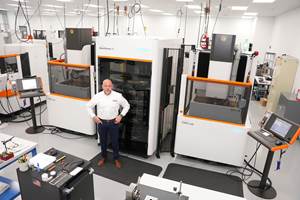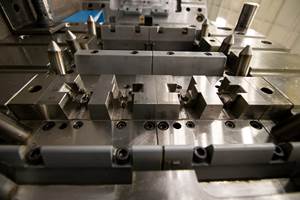EDM to a Shine With Silicon Powder EDM
A dual-tank, silicon powder process makes it possible to machine most tool steels to a highly reflective surface finish.
Imagine this moldmaking scenario: You must produce a rib style cavity using an electrode that is ten thousandths at the tip plus one degree draft per side. Then burn to a depth of minus 1.1000 inch into a piece of 420 stainless steel - no through or side flushing is used on this cut. The project requires a surface finish of one Rmax and two Rmax.
A feature like this in a mold would be a nightmare. It is impossible to grind, and a normal EDM finish would require polishing by a highly skilled polisher. In many cases, the geometry of the detail is inadvertently altered while trying to achieve the best high luster or reflective surface.
For decades, moldmakers have been utilizing EDM machines to burn parts that are too intricate to be machined on a mill. The concern with EDM machining is getting the surface finish required while increasing the unattended machine time.
After more than a decade of experience and investigation, Japanese manufacturers have discovered the newest alternative to ultra fine EDM machining. An additional dielectric tank with a silicon powder additive makes it possible to machine most tool steels to a highly reflective surface finish.
The standard oil tank provides the dielectric fluid for the standard EDM process to a point most machines would complete the EDM process. Once the normal oil process is complete, the normal oil is automatically drained and the tank automatically refills with the powder additive solution. At this point, only .0002 to .0003 inch will be machined from the surface of the detail.
The main advantage of the silicon powder additive is its ability to break the initial spark into many smaller sparks. This is possible because the silicon powder itself is a semi-conductor. This semi-conductor serves several functions:
- The semi-conductor in the fluid will make it possible for the spark to bridge the gap between the electrode and the workpiece.
- In order to have a super matte finish or a finish that is highly reflective, it is necessary that the EDM surface be very uniform. In the super matte case it is necessary that the peaks of the EDM surface be very close together. Using the semi-conductor, silicon, makes this possible.
- In order to have a highly reflective surface finish - and relatively flat - it is necessary to develop an EDM surface that is uniform in height but has wider EDM inclusions. Special technology along with the semi-conductor silicon powder makes this possible.
Because the normal EDM process and the powder process are completed using two separate tanks, there are no power restrictions during the rough burn. If an additive, such as graphite, were used, it would be necessary to limit the amount of power during roughing to reduce the possibility of arcing. Graphite powder is a full conductor unlike the semi-conductor silicon powder.
These systems that use graphite as the additive use a magnetic separator system to capture the metallic waste from the EDM process. This is necessary to limit the loss of the graphite powder additive. Using graphite powder and a magnetic separator restricts the user from EDM'ing non-ferrous materials like aluminum, titanium, Ampcoloy, Ampco, and carbides, which are non-magnetic.
Using two separate dielectric tanks overcomes this problem. One tank is for all normal oil machining situations that do not require the silicon powder process. This would include the non-metallic materials like aluminum, titanium, Ampcoloy, Ampco and all carbides. The second reservoir containing the silicon powder is only used when a super matte or highly reflective surface finish is required. The silicon powder is an environmentally safe natural element, non-toxic and inexpensive. Since silicon is a natural element, disposal of the filters or waste is not a problem. The small amount of residue that may remain in the work-tank after using the silicon powder process presents no problem when returning to a normal oil EDM situation.
Applications engineers have found that they can achieve between 600 to 800 hours of silicon powder finishing time without any additional maintenance to the machine or dielectric system. And those 800 hours only pertain to the time when the silicon powder reservoir is being used. If super matte or highly reflective surface finishing amounted to 20 percent of the total time machining, then you would have achieved 4,000 hours of machine use before maintenance would be required on the silicon powder reservoir. That may be as high as 100 weeks. The silicon powder, dual-tank system can be used to burn parts that require a super matte or highly reflective finish. The two-tank design allows the end user to consider the two-tank system as an option, like an automatic tool changer. If the option is used to fulfill the requirements of a scenario like the rib style cavity, however, the job is executed accurately and with great ease.
Related Content
Collaborative Engineering Drives Quality Mold Solutions
Advanced engineering and tooling teams collaborate to train, design, develop and deliver high-quality, cost-effective molds efficiently, ensuring perfect parts and faster launches.
Read MoreMold Builder Meets Increased Domestic Demand With Automated Cells
Burteck LLC experienced significant demand increases due to reshoring and invested in automated machining cells to step up its production output quickly and avoid losing business.
Read MoreMMT's Most-Viewed Case Studies in 2024
Did you miss any of MoldMaking Technology’s most-viewed case studies from 2024? Now’s your chance to dive into these trending topics.
Read MoreExtensive Evaluations Build The Plastek Group’s EDM Arsenal
Sinker and wire EDMs selected for speed, volumetric accuracy, surface finish, reliability, cost of ownership and extensive warranty.
Read MoreRead Next
How to Use Continuing Education to Remain Competitive in Moldmaking
Continued training helps moldmakers make tooling decisions and properly use the latest cutting tool to efficiently machine high-quality molds.
Read MoreAre You a Moldmaker Considering 3D Printing? Consider the 3D Printing Workshop at NPE2024
Presentations will cover 3D printing for mold tooling, material innovation, product development, bridge production and full-scale, high-volume additive manufacturing.
Read MoreReasons to Use Fiber Lasers for Mold Cleaning
Fiber lasers offer a simplicity, speed, control and portability, minimizing mold cleaning risks.
Read More





















